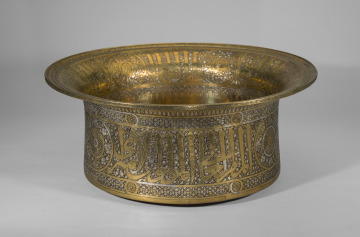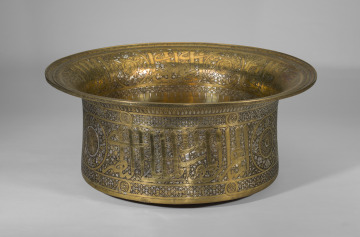Basin
- Artist Culture
- Egyptian
- Period
- Mamluk period, 1250–1517
- Date
- mid-14th century
- Material
- Brass with silver and gold inlay
- made in
- Northern Africa, Egypt, Africa
- Classification
- Containers, metalwork
- Current Location
- On View, Gallery 120
- Dimensions
- height: 9 1/4 in. (23.5 cm)
diameter of mouth: 22 1/8 in. (56.2 cm)
diameter of base: 16 1/2 in. (41.9 cm) - Credit Line
- Museum Purchase
- Rights
- Contact Us
- Object Number
- 50:1927
NOTES
This magnificent basin was used for washing, in conjunction with a pitcher. The teeming fish swimming around the bottom of the interior reflect its function, as the water would splash over them.
The stately Arabic inscriptions encircling the exterior of the basin and its interior rim indicate it was created for a high-ranking officer of the Mamluk ruler al-Malik al-Nasir (ruled 1293–1341). The Mamluks ruled Egypt and Syria from 1250 to 1517. In 1322 they signed a peace treaty with the Mongols, opening the way to trade with China. Contact with China introduced new motifs, such as the lotus flowers in the roundels on this basin.
Provenance
probably between 1885 and 1908
Ghāzī Aḥmad Mukhtār Pasha (1839–1919), likely acquired when he served as the Ottoman High Commissioner in Cairo, Egypt between 1885 and 1908 [1]
- 1927
Arthur Upham Pope (1881–1969), San Mateo, CA, USA [2]
1927 -
Saint Louis Art Museum, purchased from Arthur Upham Pope [3]
Notes:
[1] Per undated bill of sale from Arthur Upham Pope [SLAM document files]. The soldier and statesman popularly known as Ghāzī Aḥmad or Ghāzī Aḥmad Pasha was born as Aḥmad Mukhtār to a Turkish family in Bursa in the Ottoman Empire. In 1856, he served as an adjutant during the Crimean War. in 1862, he was a staff officer in the disastrous Montenegrin campaign. Between 1870 and 1871, Ghāzī Aḥmad quelled rebellions in Yemen. He gained the title of pasha (governor) of Yemen Vilayet (a first-level administrative division or vilayet of the Ottoman Empire between 1872 and 1918), and served in that capacity in the capital, Sana'a, between September 1871 and May 1873. In 1873, he was made field marshal and commander of the Second Army Corps of the Ottoman Army, holding the position until 1876. During the 1875 uprisings in Bosnia and Herzegovina, he assumed control of the Turkish forces there. On the outbreak of the Russo-Turkish War (1877–1878), he was sent to take charge of operations in Erzurum. Although the Russians ultimately defeated the Ottomans in the war, Mukhtār's victories against them in the eastern front won him the title Ghāzī ("The Victorious"). He also served as the Ottoman Governor of Crete from 1875 to 1876, and again in 1878. In 1879, Ghāzī Aḥmad Mukhtār Pasha was appointed the commander of the Ottoman Empire's frontier with Greece, before being sent in 1885 to serve as the Ottoman High Commissioner in Egypt until 1908. In 1912, he briefly served as the Grand Vizier of the Ottoman Empire.
[2] See note [1]. The Minutes state that Dikran G. Kelekian sold the basin to the Museum; however, a memo from James B. Musick corrects that error. The Museum actually purchased the basin from Arthur Upham Pope [Minutes of the Administrative Board of Control of the City Art Museum, April 22, 1927; memo, September 13, 1927, SLAM document files]. It is not known how or when Arthur Upham Pope acquired this object.
[3] See note [2].
Ghāzī Aḥmad Mukhtār Pasha (1839–1919), likely acquired when he served as the Ottoman High Commissioner in Cairo, Egypt between 1885 and 1908 [1]
- 1927
Arthur Upham Pope (1881–1969), San Mateo, CA, USA [2]
1927 -
Saint Louis Art Museum, purchased from Arthur Upham Pope [3]
Notes:
[1] Per undated bill of sale from Arthur Upham Pope [SLAM document files]. The soldier and statesman popularly known as Ghāzī Aḥmad or Ghāzī Aḥmad Pasha was born as Aḥmad Mukhtār to a Turkish family in Bursa in the Ottoman Empire. In 1856, he served as an adjutant during the Crimean War. in 1862, he was a staff officer in the disastrous Montenegrin campaign. Between 1870 and 1871, Ghāzī Aḥmad quelled rebellions in Yemen. He gained the title of pasha (governor) of Yemen Vilayet (a first-level administrative division or vilayet of the Ottoman Empire between 1872 and 1918), and served in that capacity in the capital, Sana'a, between September 1871 and May 1873. In 1873, he was made field marshal and commander of the Second Army Corps of the Ottoman Army, holding the position until 1876. During the 1875 uprisings in Bosnia and Herzegovina, he assumed control of the Turkish forces there. On the outbreak of the Russo-Turkish War (1877–1878), he was sent to take charge of operations in Erzurum. Although the Russians ultimately defeated the Ottomans in the war, Mukhtār's victories against them in the eastern front won him the title Ghāzī ("The Victorious"). He also served as the Ottoman Governor of Crete from 1875 to 1876, and again in 1878. In 1879, Ghāzī Aḥmad Mukhtār Pasha was appointed the commander of the Ottoman Empire's frontier with Greece, before being sent in 1885 to serve as the Ottoman High Commissioner in Egypt until 1908. In 1912, he briefly served as the Grand Vizier of the Ottoman Empire.
[2] See note [1]. The Minutes state that Dikran G. Kelekian sold the basin to the Museum; however, a memo from James B. Musick corrects that error. The Museum actually purchased the basin from Arthur Upham Pope [Minutes of the Administrative Board of Control of the City Art Museum, April 22, 1927; memo, September 13, 1927, SLAM document files]. It is not known how or when Arthur Upham Pope acquired this object.
[3] See note [2].






